Laid down April 1891 Struck 1922 Construction started April 1891 Length 115 m | Commissioned June 1897 Fate Broken up in 1922 Launched August 1893 Beam 22 m | |
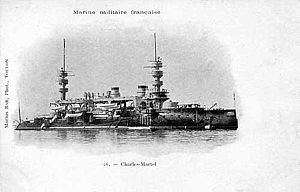 | ||
Charles Martel was a pre-dreadnought battleship of the French Navy built in the 1890s. She was laid down in April 1891, launched in August 1893, and completed in June 1897. She was a member of a group of five broadly similar battleships, along with Carnot, Jauréguiberry, Bouvet, and Masséna, which were ordered in response to the British Royal Sovereign class. Like her half-sisters, she was armed with a main battery of two 305 mm (12.0 in) guns and two 274 mm (10.8 in) guns in individual turrets. She had a top speed of 18 knots (33 km/h; 21 mph).
Contents
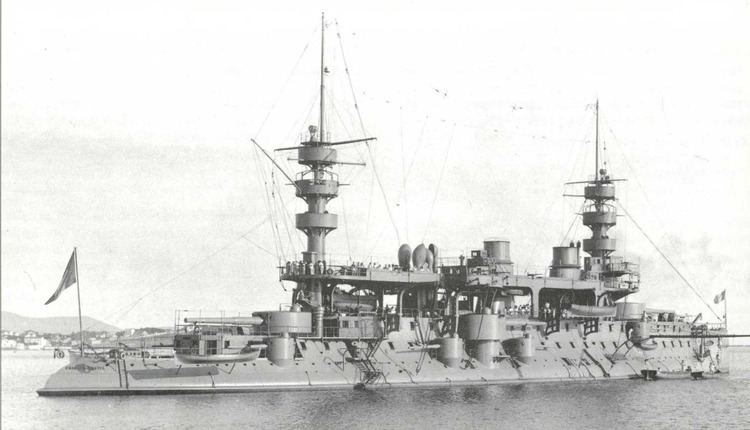
Charles Martel spent her active career in the Mediterranean Squadron of the French fleet, first in the active squadron, and later in the Reserve Squadron. She regularly participated in fleet maneuvers, and in the 1901 exercises, the submarine Gustave Zédé hit her with a dummy torpedo, which was widely hailed in the press. Charles Martel was out of service by the outbreak of World War I in 1914, and so she saw no action during the conflict. She was ultimately broken up for scrap in 1922.
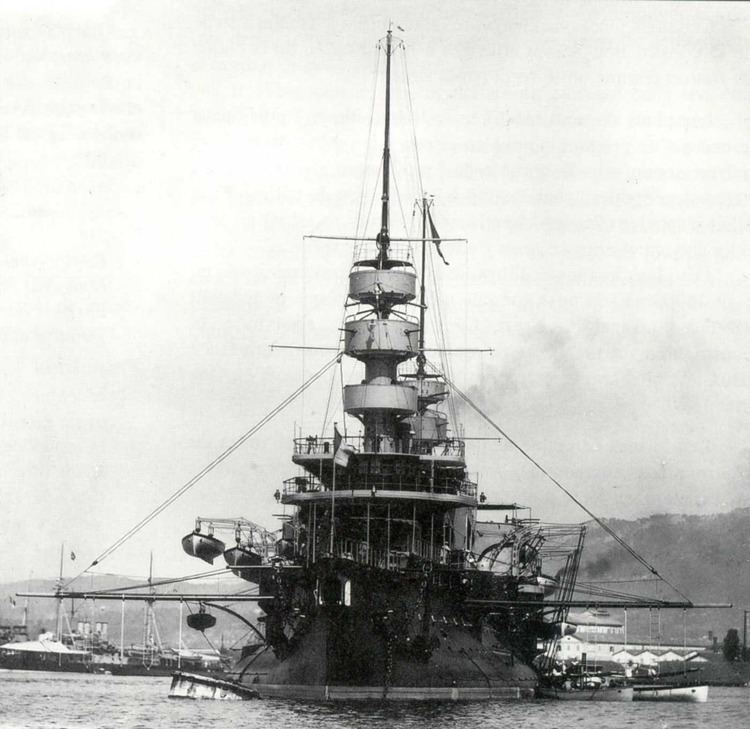
Design

Charles Martel was the first member of a group of five battleships built to a broadly similar design, but different enough to be considered unique vessels. Design specifications were identical for each of the ships, but different engineers designed each vessel. The ships were based on the previous battleship Brennus, but instead of mounting the main battery all on the centerline, the ships used the lozenge arrangement of the earlier vessel Magenta, which moved two of the main battery guns to single turrets on the wings. The five ships were built in response to the British Royal Sovereign-class battleships.
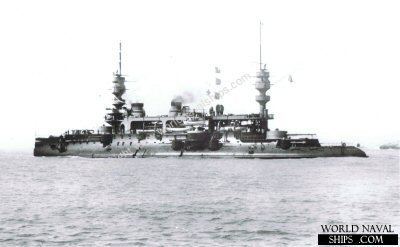
An earlier vessel, also named Charles Martel, was laid down in 1884 and cancelled under the tenure of Admiral Théophile Aube. The vessel, along with a sister ship named Brennus, was a modified version of the Marceau-class ironclad battleships. After Aube's retirement, the plans for the ships were entirely redesigned, though the later pair of ships are sometimes conflated with the earlier, cancelled designs. This may be due to the fact that both of the ships named Brennus were built in the same shipyard, and material assembled for the first vessel was used in the construction of the second. The two pairs of ships were, nevertheless, distinct vessels.
General characteristics and machinery
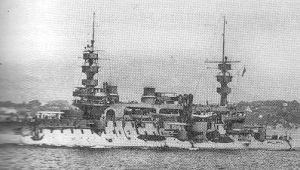
Charles Martel was 115.49 meters (378 ft 11 in) long between perpendiculars, and had a beam of 21.64 m (71 ft 0 in) and a draft of 8.38 m (27 ft 6 in). She had a displacement of 11,639 tonnes (11,455 long tons). Her forecastle gave her a high freeboard forward, but her deck was cut down to the main deck level aft. She was equipped with two heavy military masts. She had a crew of 644 officers and enlisted men.
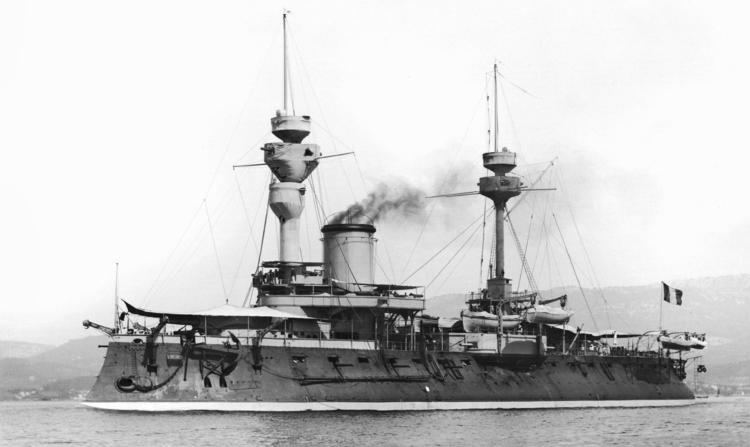
Charles Martel had two vertical triple expansion engines each driving a single screw, with steam supplied by twenty-four Lagrafel d'Allest water-tube boilers. Her propulsion system was rated at 14,900 indicated horsepower (11,100 kW), which allowed the ship to steam at a speed of 18 knots (33 km/h; 21 mph). As built, she could carry 650 t (640 long tons; 720 short tons) of coal, though additional space allowed for up to 980 t (960 long tons; 1,080 short tons) in total.
Armament and armor
Charles Martel's main armament consisted of two Canon de 305 mm Modèle 1887 guns in two single-gun turrets, one each fore and aft. She also mounted two Canon de 274 mm Modèle 1887 guns in two single-gun turrets, one amidships on each side, sponsoned out over the tumblehome of the ship's sides. Her secondary armament consisted of eight Canon de 138.6 mm Modèle 1888 guns, which were mounted in single turrets at the corners of the superstructure. She also carried four 9-pounder quick-firing guns, twelve 3-pounders, and eight 1-pounder revolving cannons. Her armament suite was rounded out by two 450 mm (18 in) torpedo tubes, which were submerged in the ship's hull.
The ship's armor was constructed with nickel steel. The main belt was 460 mm (18 in) thick amidships, and tapered down to 250 mm (9.8 in) at the lower edge. On either end of the central citadel, the belt was reduced to 305 mm (12.0 in) at the waterline and 250 mm on the lower edge; the belt extended for the entire length of the hull. Above the belt was 101 mm (4.0 in) thick side armor. The main battery guns were protected with 380 mm (15 in) of armor, and the secondary turrets had 101 mm thick sides. The main armored deck was 69 mm (2.7 in) thick. The conning tower had 230 mm (9.1 in) thick sides.
Career
Charles Martel was laid down in January April 1891 and launched in August 1893. After completing fitting-out work, she was commissioned into the French Navy in June 1897. She was delayed in completing her sea trials, as her boiler tubes had to be replaced with a safer, weld-less design, following an accident aboard Jauréguiberry with her welded tubes. Following her commissioning for service, she was assigned to the Mediterranean Squadron. In 1900, she became the flagship of Rear Admiral Roustan, the commander of the Second Division of the Mediterranean Squadron. The Mediterranean Squadron, including Charles Martel, conducted an extensive cruise with the Northern Squadron in June–July 1900, which culminated in a Grand Review of the fleet in Cherbourg at the end of July. During the 1901 maneuvers, Charles Martel was hit by a training torpedo fired by the submarine Gustave Zédé, which created an uproar in the press.
During early Summer 1902, Charles Martel was transferred to the Reserve Squadron, along with three other battleships and three armored cruisers. The ship did not participate in the annual fleet maneuvers in July–August of the following year. She remained in the Reserve Squadron, which was renamed the Second Squadron in 1906; by that time, she was in the Second Division of the Squadron, under the command of Rear Admiral Germinet. The ship was maintained in a state of en disponibilité armée, a state of reduced readiness with a minimal crew. Charles Martel was in full commission for three months of the year, and in reserve with a reduced crew for the remainder. She remained in this status for the duration of 1907.
By the outbreak of World War I in August 1914, Charles Martel had been laid up in the port of Brest, along with Carnot. Both ships were retained on the effective list, however, pending the completion of the new Normandie-class battleships. Charles Martel was ultimately stricken from the naval register in 1922 and sold for scrapping that year.
